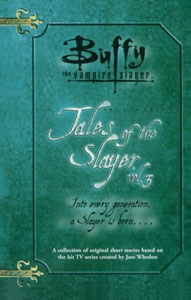It’s like an all-star writing contest when Yvonne Navarro, Mel Odom, Christopher Golden and Nancy Holder get together to write four novellas for “Tales of the Slayer, Vol. 3” (November 2003). At this point in my reread, they are four of the five best Buffyverse writers (with Jeff Mariotte filling the other spot). Here are my rankings of their contributions in this third “Tales” volume:
1. “Voodoo Lounge” (1940, Los Angeles) by Golden – Golden describes this era of Hollywood so well that I had to look up if the Voodoo Lounge and actress Grace McCandless (an actress friend of Angel’s from “The Longest Night” who cameos here) are real. They aren’t, but Golden paints a transporting picture of a club where demons and humans intermingle. It’s like that era’s Caritas and a metaphor for race relations, but while the West Coast was a bit more forward-thinking than the rest of the country, it is still an underground club.
It’s a pleasant surprise to catch up with Louisiana-bred Eleanor, who is chosen at the end of “Spike and Dru: Pretty Maids All in a Row.” She is gaining confidence as a Slayer and as a young woman as she and her Watcher, Marie-Christine, investigate the disappearance of a Council member and a murder spree of innocent demons. Angel doesn’t pop in for a cameo, but in theme and structure, the mystery has a nice “Angel” vibe.
5 stars
2. “Ch’ing Shih” (1856, Shanghai) by Odom – Shanghai during the time of the Slayer Xiaoqin is an evocative place to visit, but I wouldn’t want to live – or even visit – there in reality. The city is dominated by English merchants while most of the populace lives in squalor, and young girls have it worst of all since they are seen as worthless in Chinese culture. Xiaoqin therefore has to disguise herself as a man (something two historic Slayers from Vol. 2 also do) while looking after a growing cadre of girls. They live in the basement of a burned-out building, and the Slayer has to guard that squalid piece of real estate judiciously. When the Slayer battles the wonderfully named vampire Fang-Chou, it’s a comparative relief.
After Xiaoqin meets her Watcher, Connelly, she gets paralyzed in battle and the recovery scenes at a monastery are intriguing, as her recuperative powers eventually make her un-paralyzed. One oddity of this tale is that Connelly recognizes the Slayer by a birthmark and the fact that she gets cramps when vampires are near. These traits from the “Buffy” movie were scrapped when that script was repackaged in “The Origin” comic. I suppose one could argue that these sign posts can still indicate a Slayer, but they are not universally reliable, and that’s why they don’t come up in other tales.
4.5 stars
3. “The Code of the Samurai” (1993, Japan) by Holder – As with Golden continuing Eleanor’s story, here Holder digs into her creation, India Cohen from “The Book of Fours.” In that book, Buffy’s immediate predecessor is often in ghost form, but here we see her early days when she has a crush on her Watcher, Kit, and is gaining confidence as the Slayer and as an American living in Japan.

As is often the case with Holder yarns, a lot of text is given to the backstory of the villains, but in this case it’s a good thing because she has come up with a juicy concept. In the 1700s, the leader of a Samurai clan is turned into a vampire, and through the centuries, that branch of the clan has warred with the human branch. Holder transports us to the historic time with details of the clan’s internal politics – which makes the villain’s plight rather sympathetic – and delicious euphemisms such as “pillowing” (the task performed by concubines).
4 stars
4. “Dark of the Moon” (1229, Anasazi settlement) by Navarro – Navarro does good world-building as the young Anasazi woman Dark of the Moon experiences the acquisition of her Slayer powers and fights vampires, all without knowing what a Slayer or vampires are (although the tribe’s elders have somewhat of an idea). Everything we as readers are familiar with is new to her, and Navarro mostly puts the reader right alongside Dark of the Moon.
Still, compared to the other three tales, this one plods. It has a similar hopeless quality to Odom’s tale, where normal daily life is not much more enjoyable than fighting vampires. While the clincher about a vampire incursion explaining the disappearance of the Anasazi certainly fits, it’s also wholly expected.
3 stars
Click here for an index of all of John’s “Buffy” and “Angel” reviews.

